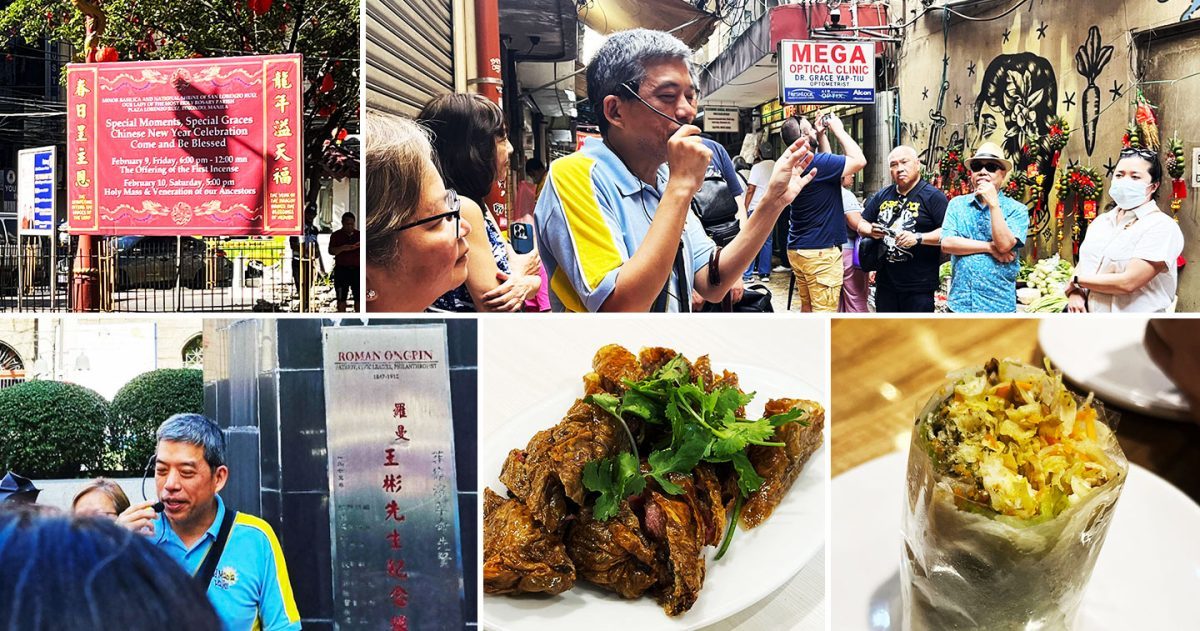MANILA, PHILIPPINES — When one goes to Binondo, one often goes to eat. But when taking my friend who had come from Australia, I didn’t want to just take her to one place that had my favorites. I wanted to take her everywhere and get a taste of everything. After watching the Manila episode of Anthony Bourdain’s Parts Unknown, we found that his guide, Ivan Man Dy, was doing tours of Manila under the name Old Manila Walks. We opted for The Big Binondo Food Wok, a leisurely food tour of Binondo’s eating establishments while exploring the area’s history.
The Binondo food trip begins
The Binondo food tour began at 9:30 a.m. at the entrance of the Binondo Church. The banner that hung across the street was advertising for Holy Mass and Ancestor Veneration in the same line, a mix of Catholic and Confucian culture that set the tone for the rest of the day.


Outside the statue of Roman Ongpin, we had a brief geography lesson. Binondo was considered Extramuros, “outside the wall,” where those unfortunate enough not to be Spanish lived. Often, when this area is discussed in history books, much focus is put on Intramuros, the enclave where the Spanish ruled. But outside the walls, there was also a rich history of those who were native to the island and those who came from elsewhere. Our journey into Filipino heritage food began at Polland with our first meal, lumpia.
Our next stop on the Manila Chinatown food tour involved uneven pavements and a brief stroll through the wet market on Carvajal Street, where vendors were plying special Lunar New Year items. Ivan explained that these “lucky items” with red ribbons that were given at this time of year were either based on wordplay or the properties of the food itself. Oranges sound like gold or luck, depending on your dialect, and their bright colors resemble coins. Pineapple sounds similar to the phrase “beckoning luck.” I had seen these fruits used as decoration during this time of year but was unaware of the origin of their symbolism.



The third stop on our food tour that’s also worth visiting when doing a Binondo photowalk was Quik Snack (Carvajal St, Binondo), a local haunt founded in 1967. In a time when women were expected to be caretakers of the home, Ahma Pilar opened a restaurant at the age of sixty and ran it till her death. The dishes were inventive and fresh, with our heaviest meal of the day consisting of Kutchay-Ah, an empanada-styled handpie filled with chives, meat, and radish; egg noodles with beef and kangkong in a satay soup, and tokwa, fried tofu in a sweet soy sauce with chili and fresh beansprouts.
At this time, I was reminded that there were four stops on this tour and that there was still one more stop, but the staff at Quik Snack brought a special dessert for us on the house to celebrate the new year —sweet sticky rice with coconut. I didn’t know whether I could take a bite of anything from our last stop, where we were having dessert.


The final bite of the Binondo food adventure
We looped back to near the church and ended up in the flagship store of the famed deli Eng Bee Tin (628 Ongpin Street, Binondo). Our Chinatown food tour ended with hopia, a food that perfectly symbolized Chinese-Filipino sensibilities. Chinese pastry preparation with Filipino ingredients, as the puff pastry would be filled with the local bean munggo instead of the more common red beans in Chinese cuisine. A sweet burst of flavor ended the tour, and Ivan invited us to go shopping should anything in the store take our fancy. There was barely any room to browse as I navigated between people purchasing comically large amounts of tikoy, fortune cookies, and hope to give to relatives, workmates, and friends.
It was at this point our tour concluded, and I thanked Ivan for his time and his knowledge. I came to this tour expecting samplers and came out with a full stomach, having tried full platters of things I normally would not have tried for myself. This experience was certainly off the beaten track and illuminated parts of local history I was unaware of, leaving me with new knowledge and a new appreciation for Chinese-Filipino food.
Tours, requiring prior reservation, can be booked through the official site. The Big Binondo Food Wok is priced at PHP 1,850 per head (PHP 2,000 on weekends and holidays), covering meals. Their adherence to the DOT health and safety guidelines ensures a secure and enjoyable culinary experience for all participants.








